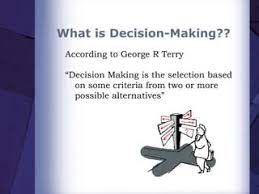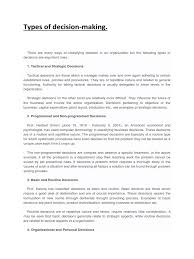Strategic decisions are critical for the success of any organization. They are the decisions that shape the future direction of the company and determine its long-term success. Strategic decisions are made by top-level executives and involve allocating resources, setting goals, and choosing among various options. There are several types of strategic decisions that organizations can make.
- Business Level Strategy: This type of strategic decision involves determining how a company will compete in a particular market. This includes deciding on the products or services to offer, pricing strategies, target customers, and distribution channels. Business level strategy is critical for companies to differentiate themselves from their competitors and achieve a competitive advantage.
- Corporate Level Strategy: Corporate level strategy involves determining the overall direction of a company. This includes deciding on which businesses to enter or exit, mergers and acquisitions, diversification strategies, and resource allocation across different business units. Corporate level strategy is important for companies to achieve growth and maximize shareholder value.
- Functional Level Strategy: Functional level strategy involves making decisions about how each department within an organization will contribute to achieving overall business goals. This includes marketing strategies, operational strategies, financial strategies, and human resource strategies. Functional level strategy is important for ensuring that each department is aligned with the overall goals of the organization.
- International Strategy: International strategy involves making decisions about how a company will operate in foreign markets. This includes deciding on which countries to enter or exit, modes of entry (such as joint ventures or wholly-owned subsidiaries), product adaptation strategies, and marketing strategies tailored to local cultures and preferences.
- Technological Strategy: Technological strategy involves making decisions about how technology can be leveraged to achieve business objectives. This includes developing new products or services based on emerging technologies, investing in research and development activities, adopting new technologies to improve operational efficiency or customer experience.
In conclusion, strategic decisions are critical for organizations to succeed in today’s highly competitive business environment. The types of strategic decisions that an organization makes will depend on its goals, resources, and competitive landscape. By understanding the different types of strategic decisions, organizations can make informed decisions that will help them achieve their long-term objectives.
Frequently Asked Questions About Types of Strategic Decisions
- What are the 10 strategic decisions in operations management?
- What are examples of strategic decisions?
- What are the three types of strategic decisions?
- What are the 7 decision making strategies?
What are the 10 strategic decisions in operations management?
Operations management involves making strategic decisions to ensure that an organization’s resources are used efficiently and effectively to achieve its goals. There are several key strategic decisions that operations managers must make in order to optimize their organization’s performance. Here are 10 strategic decisions in operations management:
- Product and Service Design: This involves deciding on the features, functions, and specifications of a product or service.
- Capacity Planning: This involves determining the amount of resources (e.g., labor, equipment, space) needed to meet demand for a product or service.
- Process Design and Layout: This involves designing efficient processes and layouts that minimize waste, reduce costs, and improve quality.
- Quality Management: This involves developing systems to ensure that products or services meet or exceed customer expectations.
- Supply Chain Management: This involves managing the flow of goods and services from suppliers to customers, including procurement, transportation, warehousing, and inventory management.
- Inventory Management: This involves managing inventory levels to balance the costs of holding inventory with the costs of stockouts.
- Scheduling: This involves determining when tasks should be performed in order to maximize efficiency and minimize idle time.
- Maintenance Management: This involves developing systems for maintaining equipment and facilities to minimize downtime and repair costs.
- Human Resource Management: This involves managing personnel issues such as recruitment, training, performance evaluation, compensation, and labor relations.
- Sustainability Management: This involves managing operations in a way that minimizes negative environmental impacts while maximizing social benefits and economic value.
By making informed decisions about these 10 strategic areas of operations management, organizations can improve their competitiveness by reducing costs, improving quality, increasing efficiency, enhancing customer satisfaction, and achieving sustainability goals.
What are examples of strategic decisions?
There are many examples of strategic decisions that organizations make to achieve their long-term objectives. Here are some common examples:
- Product Development: Deciding which new products or services to develop and bring to market is a critical strategic decision. Companies must consider factors such as customer needs, market trends, and competitive landscape when making these decisions.
- Market Expansion: Deciding whether to expand into new markets or regions is another important strategic decision. Companies must consider factors such as market size, growth potential, regulatory environment, and cultural differences when making these decisions.
- Mergers and Acquisitions: Deciding whether to acquire another company or merge with a competitor is a major strategic decision. Companies must consider factors such as the potential benefits of the transaction, the risks involved, and the cultural fit between the two organizations.
- Resource Allocation: Deciding how to allocate resources such as capital, personnel, and technology across different business units or projects is a critical strategic decision. Companies must balance competing priorities and ensure that resources are aligned with overall business goals.
- Branding and Marketing: Deciding how to position a brand in the marketplace and how to market products or services is a key strategic decision. Companies must consider factors such as target audience, messaging, advertising channels, and promotional activities when making these decisions.
- Talent Management: Deciding how to attract, retain, and develop talent is an important strategic decision for any organization. Companies must consider factors such as compensation packages, training programs, career paths, and organizational culture when making these decisions.
These are just a few examples of the many types of strategic decisions that organizations make on an ongoing basis in order to achieve their long-term objectives.
What are the three types of strategic decisions?
There are several types of strategic decisions that organizations can make, but the three main types of strategic decisions are:
- Corporate-level strategy: This type of strategic decision involves determining the overall direction of a company. It includes deciding on which businesses to enter or exit, mergers and acquisitions, diversification strategies, and resource allocation across different business units.
- Business-level strategy: This type of strategic decision involves determining how a company will compete in a particular market. It includes deciding on the products or services to offer, pricing strategies, target customers, and distribution channels.
- Functional-level strategy: This type of strategic decision involves making decisions about how each department within an organization will contribute to achieving overall business goals. It includes marketing strategies, operational strategies, financial strategies, and human resource strategies.
By making informed decisions in these three areas, organizations can achieve their long-term objectives and succeed in today’s highly competitive business environment.
What are the 7 decision making strategies?
There are several decision-making strategies that individuals and organizations can use to make informed choices. Here are seven common decision-making strategies:
- Cost-Benefit Analysis: This strategy involves weighing the potential costs and benefits of different options before making a decision. It helps individuals or organizations to choose the option that provides the greatest benefit while minimizing costs.
- Pros and Cons: This strategy involves listing out the advantages and disadvantages of each option before making a decision. By analyzing the pros and cons, individuals or organizations can make an informed choice based on their priorities.
- Decision Trees: This strategy involves mapping out different options and their potential outcomes in a visual format. Decision trees help individuals or organizations to understand the potential consequences of each option before making a choice.
- SWOT Analysis: SWOT stands for Strengths, Weaknesses, Opportunities, and Threats. This strategy involves analyzing these four factors to determine which option is best suited for achieving goals.
- Group Decision Making: This strategy involves involving multiple stakeholders in the decision-making process to ensure that all perspectives are considered before making a choice.
- Intuition: Sometimes, individuals or organizations may rely on their gut instinct or intuition when making decisions. While this strategy may not be based on data or analysis, it can be useful in certain situations where time is limited, or there is no clear answer.
- Trial and Error: This strategy involves trying out different options until one works best for achieving goals. While this approach can be time-consuming, it can also lead to innovation and learning from mistakes.
In conclusion, choosing the right decision-making strategy depends on various factors such as goals, resources available, time constraints, etc., but understanding these seven common strategies can help individuals and organizations make informed choices that align with their objectives.



